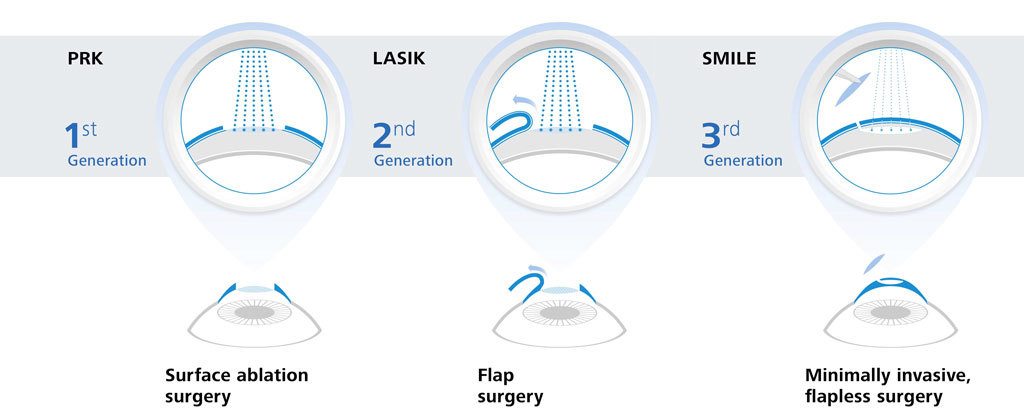Just How Does SMILE Eye Surgery Compare To LASIK And PRK?
Just How Does SMILE Eye Surgery Compare To LASIK And PRK?
Blog Article
Content Produce By-Fischer Chase
If you've been considering SMILE eye surgical treatment, you could wonder exactly how it compares to LASIK and PRK. Each treatment has its very own set of benefits and considerations. From quicker healing times to prospective threats, there are key differences you must be aware of prior to deciding. Comprehending these differences will help you make an informed selection that aligns with your details demands and assumptions. Interested to recognize more concerning exactly how these procedures contrast in detail? Keep checking out to acquire an extensive understanding of SMILE, LASIK, and PRK.
SMILE Eye Surgical Procedure Overview
If you're thinking about SMILE eye surgical treatment, you'll find it to be a minimally intrusive procedure with a quick recovery time. Throughout SMILE (Small Incision Lenticule Extraction), a laser is made use of to create a tiny, accurate cut in the cornea to eliminate a small piece of tissue, improving it to fix your vision. This varies from LASIK, where a flap is created, and PRK, where the external layer of the cornea is totally gotten rid of.
Surgery Cost LASIK of the vital advantages of SMILE is its minimally intrusive nature, causing a faster healing process and much less discomfort post-surgery. The recovery time for SMILE is fairly quick, with numerous clients experiencing improved vision within a day or two. This makes it a preferred choice for those looking for a practical and reliable vision adjustment procedure. Additionally, SMILE has been revealed to have a lower risk of completely dry eye disorder contrasted to LASIK, making it a positive choice for people worried concerning this prospective side effect.
Differences Between SMILE, LASIK, and PRK
When comparing SMILE, LASIK, and PRK eye surgical treatments, it is essential to comprehend the distinctive strategies made use of in each treatment for vision modification.
SMILE (Tiny Laceration Lenticule Removal) is a minimally intrusive procedure that involves developing a little laceration to remove a lenticule from the cornea, improving it to deal with vision.
LASIK (Laser-Assisted Sitting Keratomileusis) includes developing a slim flap on the cornea, using a laser to improve the underlying cells, and then repositioning the flap.
PRK (Photorefractive Keratectomy) gets rid of the outer layer of the cornea prior to reshaping the tissue with a laser.
The primary distinction lies in the way the cornea is accessed and treated. SMILE is flapless, making it an excellent alternative for individuals with slim corneas or those associated with get in touch with sports. LASIK supplies quick aesthetic recovery due to the flap creation, however it may position a greater risk of flap-related problems. PRK, although having a much longer healing period, prevents flap-related problems altogether.
Comprehending these variations is crucial in choosing the most appropriate procedure for your vision correction requirements.
Advantages And Disadvantages Contrast
To review the benefits and drawbacks of SMILE, LASIK, and PRK eye surgical procedures, it's vital to take into consideration the particular benefits and prospective constraints of each procedure. How Much Does Bladeless LASIK Cost uses the benefit of a minimally intrusive procedure, with a smaller laceration and possibly quicker recuperation time contrasted to LASIK and PRK. It additionally reduces the threat of dry eye post-surgery, an usual negative effects of LASIK. However, after cataract surgery sensitivity to light might have constraints in dealing with greater levels of myopia or astigmatism compared to LASIK.
LASIK surgery offers rapid visual healing and minimal pain throughout the procedure. It's extremely reliable in dealing with a variety of refractive mistakes, including nearsightedness, hyperopia, and astigmatism. Yet, LASIK brings a threat of flap issues, which can affect the corneal framework.
PRK eye surgical treatment, while not as popular as LASIK, prevents developing a corneal flap, minimizing the risk of flap-related difficulties. It appropriates for patients with thin corneas or irregular corneal surfaces. Nevertheless, PRK has a much longer recovery time and may entail extra pain throughout the recovery procedure.
Conclusion
So, when it involves choosing between SMILE, LASIK, and PRK, think about it like selecting the excellent set of footwear. SMILE is like a streamlined, comfy pair of tennis shoes - quick and very easy.
LASIK is a lot more like stylish high heels - flashy and fast, yet with some potential dangers.
PRK is like strong hiking boots - trustworthy and sturdy, but calling for a little bit more effort and time.
Inevitably, the best choice depends on your individual needs and preferences.
